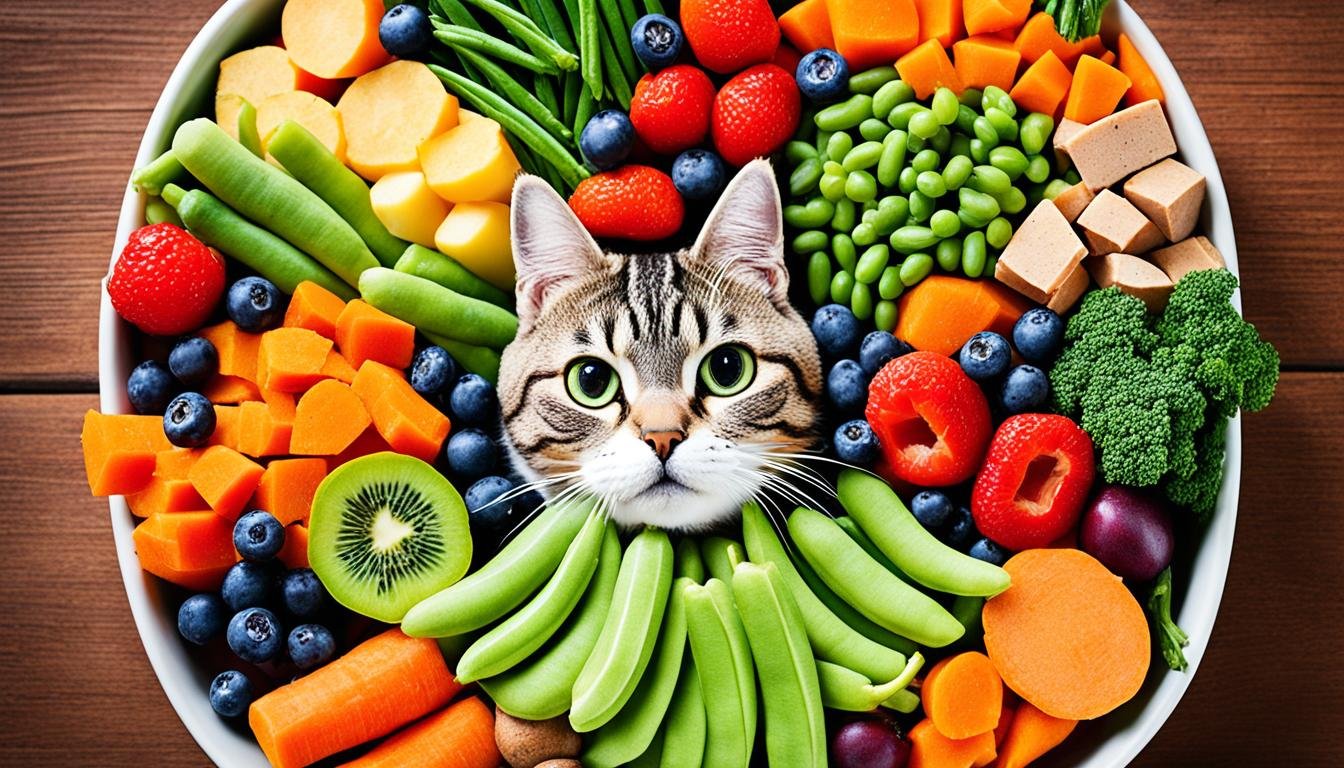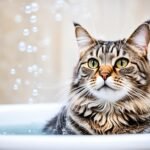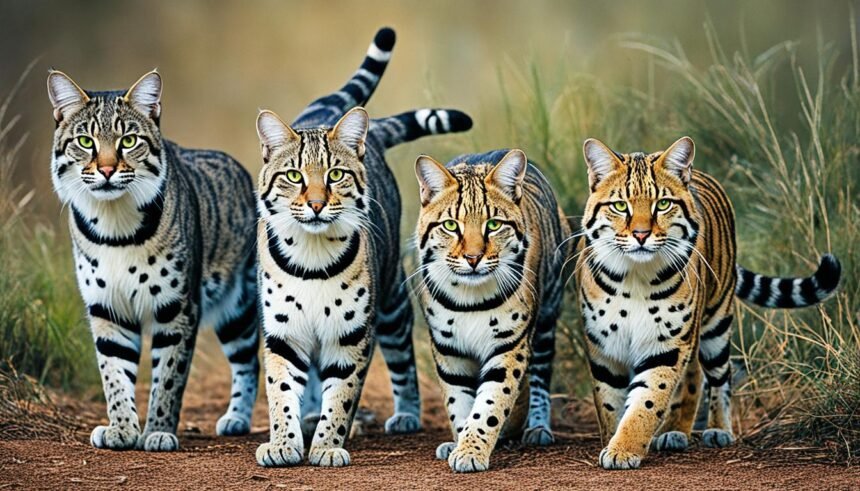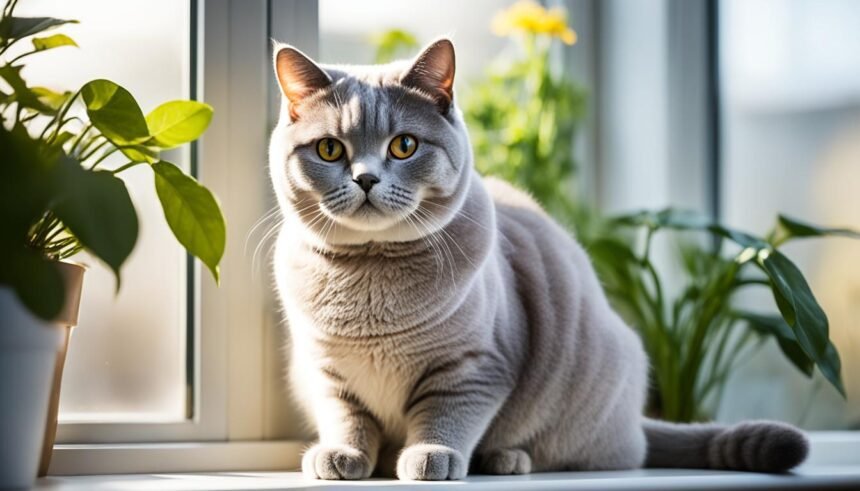Every cat owner needs to know that their cat’s diet affects their health and energy. It’s important to give your cat high-quality cat food for a balanced diet. This helps keep your cat at a healthy weight. Also, setting a regular feeding schedule is key. And if your cat has special needs, you’ll have to consider those too.
Having enough water is also critical for your cat’s health. Always make sure fresh water is available to go with their meals. Treats are nice, but use them wisely to avoid health problems. Understanding what to feed your cat can be tricky. Yet, we’re here to help you make the best choices for feeding your cat well.
Understanding Your Cat’s Nutritional Needs
Knowing how to feed your cat well is key to their health. The right nutrients help them stay active and healthy.
Importance of a Balanced Diet
A balanced diet keeps your cat healthy and prevents health problems. It’s important for their energy and happiness.
Proteins, Fats, and Carbohydrates
Proteins help your cat grow strong muscles and repair them. Fats give them energy and help them use vitamins well.
Carbohydrates are also needed but in the right amounts. They give energy and help with digestion.
Vitamins and Minerals for Feline Wellness
Vitamins and minerals are crucial for your cat’s health. They help with bones, seeing, and fighting off diseases. A good diet provides these essentials.
| Nutrient | Benefits | Recommended Sources |
|---|---|---|
| Proteins | Muscle development and repair | Chicken, turkey, fish |
| Fats | Energy, vitamin absorption | Salmon oil, chicken fat |
| Carbohydrates | Energy, digestive health | Brown rice, barley |
| Vitamins | Immunity, metabolism | Liver, eggs, leafy greens |
| Minerals | Bone strength, oxygen transport | Meat, cheese, fish |
Choosing the Right Cat Food
As a pet owner, choosing cat food is key for your cat’s health and happiness. There are many options, like dry food and wet food. It’s important to know the pros and cons. This helps avoid fillers and by-products. Let’s look at what to consider when picking pet food.
Dry Food vs. Wet Food: Pros and Cons
Dry food is easy to store and lasts a long time. It helps keep teeth clean by reducing plaque. But, it has less moisture than wet food. So, ensure your cat drinks enough water.
Wet food has more moisture, which is good for urinary health. It also has more protein and less carbs, like a natural cat diet. But, it costs more and doesn’t last long after opening.
Reading and Understanding Pet Food Labels
It’s crucial to read pet food labels correctly. Look past the packaging and check the ingredients list. The first few items show what the food mainly contains. Protein should be clear, not just labeled as “meat products”.
Also, check the nutritional adequacy statement. It shows if the food meets the AAFCO guidelines for a balanced diet.
The Truth About Fillers and By-Products in Cat Food
Fillers and by-products are often used to save money. Fillers like corn and wheat can cause weight gain without good nutrition. By-products can vary in quality. It’s important to pick brands that are open and high-quality.
Making an informed choice is essential for your cat’s diet. By learning about these things, you can find nutritious, enjoyable food that supports your cat’s health for years to come.
How to Feed Your Cat for Maintaining a Healthy Weight
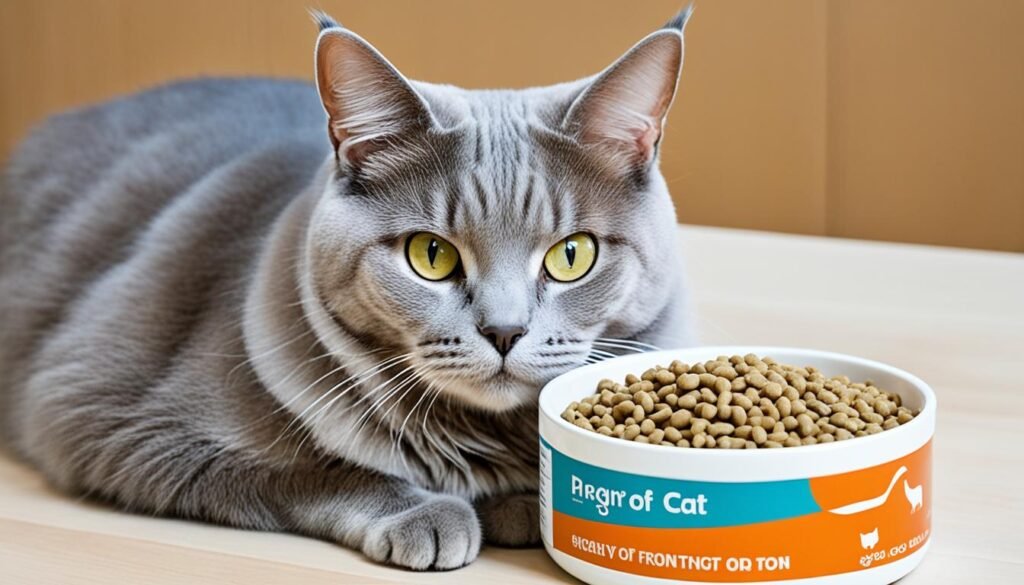
Keeping your cat at a healthy weight is very important. It’s good for them just like it is for us. By watching their body condition and following the right feeding rules, you can avoid health problems. These can come from either being too heavy or too thin. Let’s find out how to make sure your cat is always feeling great.
- Check how your cat looks and feels often to catch any needed changes in their diet. A healthy cat should have a visible waist and just a bit of belly fat.
- To stop overfeeding, use a standard measuring cup and ask your vet about the right amount for your cat.
- Follow feeding rules that fit your cat’s age, how active they are, and any health issues. The info on cat food packages gives a basic idea, but your vet’s advice is best.
Knowing what nutrients your cat needs helps them stay at a good weight. Here’s a basic guide on how much to feed them.
| Weight Range | Portion Size (Dry Food) | Portion Size (Wet Food) | Feeding Frequency |
|---|---|---|---|
| 5-10 lbs | 1/4 to 1/2 cup | 3/4 to 1 can | Twice daily |
| 10-15 lbs | 1/2 to 3/4 cup | 1 to 1 1/2 cans | Twice daily |
| 15-20 lbs | 3/4 to 1 cup | 1 1/2 to 2 cans | Twice daily |
Remember, these are just rough ideas. Your vet can give you the best advice for your cat’s specific needs. This will help your cat stay at a healthy weight.
Setting a Feeding Schedule
Creating a feeding schedule for your cat helps their health and happiness. Whether you choose feeding once or twice a day or free feeding can depend on your cat’s needs. Cats that can control their eating may do well with free feeding.
Cats like routine, and regular meals per day make them feel safe. It reduces their stress about feeding times. Vets often suggest feeding them twice a day. It’s more natural for them and stops them from eating too much.
| Feeding Option | Pros | Cons |
|---|---|---|
| Free Feeding | Convenience Less demanding on owner’s schedule Allows cats to choose their own feeding times |
Risk of overeating Not suitable for weight management Difficult to monitor intake |
| Feeding Once a Day | Suitable for very active cats with high energy needs | May lead to hunger-related stress Complication with medication schedule Not recommended for most cats |
| Feeding Twice a Day | Mimics natural hunting behaviour Fits well with medication timing Good for weight control |
Requires a consistent schedule May be less convenient for some owners |
For homes with many cats or cats on diets, setting regular feeding times is key. It helps avoid overfeeding or underfeeding. Take into account the cat’s age, health, and activity level when creating a feeding schedule.
Kittens need three to four meals a day for growth, but adult cats do well with two.
- Morning meal: Serve breakfast aligned with your daily routine for your cat.
- Evening meal: Offer the second meal as the household calms down, giving a peaceful feeding time.
With a good feeding schedule, your cat’s digestion and overall health can improve. It also lets pet owners bond with their cats, making mealtime enjoyable for both.
Special Dietary Considerations
Cat owners know that from the youngest kitten to the oldest cat, each needs a specific diet. It’s essential to understand the special dietary considerations for their health. We will look into what different life stages, from feeding kittens to caring for senior cats, need. This also includes managing common health issues like obesity, diabetes, and allergies.
Feeding Your Kitten: A Developmental Approach
Young cats grow fast and need food high in proteins, fats, and certain nutrients. Their meals should support their rapid development and high energy. This approach is crucial for their health.
Addressing the Needs of Senior Cats
Senior cats experience a slower metabolism. They need less calorie-rich but more digestible foods and fiber. Watching their diet helps keep their weight steady and reduces health risks.
Managing Dietary Concerns: Obesity, Diabetes, and Allergies
Dealing with obesity and diabetes means careful diet and portion management. For cats with allergies, it’s important to find and avoid what causes their reactions. This helps them live without symptoms.
| Life Stage | Caloric Requirements | Protein | Special Notes |
|---|---|---|---|
| Kitten | High | Rich | Focus on DHA for brain development |
| Adult | Moderate | Moderate to High | Balance with activity level |
| Senior | Lower | Highly Digestible | Increased fiber, less fat |
| Obese/Diabetic | Managed | Varies | Tailored for weight loss/maintenance |
| Allergic | Varies | Hydrolyzed/Novel | Elimination diet to identify triggers |
Hydration Is Key to Your Cat’s Health

Keeping your cat hydrated is as vital as giving them the right food. It affects their kidneys, energy, and overall wellness. For cat owners, knowing the value of hydration prevents health issues. It also makes their cats’ lives better.
Why Fresh Water Access is Crucial
Cats naturally drink little water. They got this trait from their ancestors who lived in deserts. This can lead to not drinking enough, especially with dry food. So, it’s important cats have fresh water. It stops dehydration and keeps their kidneys working well. Fresh, oxygen-rich water gets cats to drink more, meeting their hydration needs.
The Role of Moisture in Feline Food
Adding moisture to cat food helps with hydration. Wet food has more water, which is good, especially for cats that don’t drink a lot. This water in their food means they get hydrated with every meal, beyond just drinking water. Using canned food, pouches, or adding water to dry food helps increase their water intake.
| Hydration Source | Benefits | Tips for Encouraging Use |
|---|---|---|
| Fresh Water Bowls | Easy access to water, encourages regular drinking habits | Place multiple bowls around the home, clean and refill daily |
| Water Fountains | Oxygenated water, appeals to a cat’s preference for running water | Introduce gradually, ensure quiet operation to not deter use |
| Moist or Wet Food | Provides hydration through diet, beneficial for cats that eat less dry food | Choose high-quality brands, mix with dry food for texture variety |
| Add-ins to Kibble | Increases total water intake, can entice picky eaters | Add warm water or broth to kibble, making it more palatable |
The Risks and Rewards of Treats and Human Food
Giving cat treats and human food to our cat friends needs careful thought. It’s all about balancing the risks and rewards. An occasional treat can be good for bonding or training. But, it’s important to know which human foods are bad for them. It is also key to know how treats should be part of your cat’s diet. Being responsible in giving treats helps keep your cat both happy and healthy.
Knowing about risky foods and better options is crucial. Below is a table. It shows some common human foods cat owners might think of giving their pets. It also includes the risks these foods might have. Plus, it offers healthier treat alternatives.
| Human Food | Potential Risk to Cats | Healthier Cat Treat Alternative |
|---|---|---|
| Chocolate | Contains theobromine, which is toxic to cats | Commercially prepared cat treats without additives |
| Onions/Garlic | Can cause gastrointestinal irritation and red blood cell damage | Fresh, lean meats like cooked chicken or turkey |
| Grapes/Raisins | Known to cause kidney failure in cats | Small portions of cooked fish such as salmon or tuna |
| Dairy Products | Many adult cats are lactose intolerant | Lactose-free cat milk or specialized cat yogurt |
| Raw Meat/Eggs | Risks of E. coli or Salmonella infection | Cooked eggs or commercial freeze-dried cat treats |
Understanding these risks and rewards shows how important moderation and knowledge are. Treats, whether cat treats or selected human foods, should be less than 10% of your cat’s daily calories. This makes sure treats do not take over the main diet which gives essential nutrients. Always talk to your vet before giving new foods to your cat. This helps keep them healthy for a long time.
Feed Your Cat: Making Smart Choices for Your Feline Friend
Taking care of your cat means knowing what they need to eat. It’s important to choose the right food for them. We’ll show you how to pick the best food that fits your cat’s needs.
- Begin by assessing your cat’s life stage, activity level, and health condition to tailor smart food choices.
- Seek veterinarian recommendations particularly if your cat has specific health requirements or dietary restrictions.
- When introducing a new food, gradually mix it with the old food over 7-10 days to prevent digestive upset.
| Consideration | Details | Veterinarian Insights |
|---|---|---|
| Life Stage | Kittens, adults, and seniors have differing nutritional profiles; Choose age-appropriate food | Formulated for growth, maintenance, or senior support |
| Activity Level | More active cats may require higher calorie diets. | Monitor weight and adjust portions as necessary |
| Health Condition | Cats with conditions like obesity or kidney disease need specially formulated diets | Prescription diets may be recommended for certain health issues |
| New Food Introduction | Mix new food with current diet gradually to adjust | Observe for any adverse reactions or allergies |
Remember, the food you give your cat really matters. Always choose meals that are full of nutrients. These will help your cat live a happy, healthy life.
Conclusion
In our detailed guide, we’ve looked into how to feed your cat healthily. We covered their complex nutritional needs and how to pick the right food. This is key to keeping your pet healthy and full of life.
Setting a good feeding schedule and keeping an eye on how much they eat is important. Don’t forget, cats need the right amount of water too. This helps make sure their diet works well. Too many treats can upset this balance, so it’s best to be careful.
Knowing what and how to feed our cats shows how much we care. The tips you’ve learned can really help your cat live a happy, healthy life. We hope you use this knowledge well for your furry friend’s best future.

